THE DEMON BARBER OF GEORGE STREET
DID JACK THE RIPPER LIVE IN HASTINGS?
By Helena Wojtczak In 1888 a serial killer called Jack the Ripper terrorised the streets of London’s East End. He was never caught and his identity remains a mystery to this day. More than 170 names have been put forward as possible suspects, including Queen Victoria’s grandson the Duke of Clarence and the artist Walter Sickert. But many people believe that Jack the Ripper was a man called George Chapman, who worked for a time as a barber in George Street, Hastings.
George Chapman was the pseudonym of Seweryn Klosowski, who was born in Poland in 1865. By 1888 he was in the East End of London, living close to all the scenes of the Jack the Ripper murders. In February 1896 he, his girlfriend Mary Spink and her young son Willie moved to Hastings, where, using Mary’s inheritance, Chapman bought the lease of a small lock-up shop in George Street. They took lodgings nearby, living firstly at Hill Street and then at Cobourg Place. The fourth Hastings location linked to Chapman was the chemist’s shop at 66 High Street. Here, Chapman purchased sufficient quantities of a poison called tartar emetic to kill forty people.

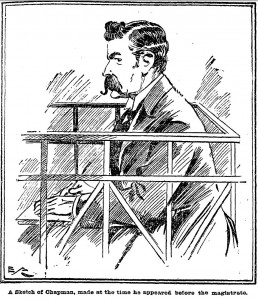
The shop Chapman leased did not exist until 1894. It was set into the rear of the Albion Hotel, which faces the English Channel. Built in 1831 in a grand style the hotel saw a decline in business by the 1890s and the ground floor was divided. The front became the Royal Albion public house; the rear was partitioned into a short row of lock-up units opening onto George Street. Chapman leased the last shop, at the western end of the row, and set up as a barber, umbrella repairer and (walking) stick merchant. According to locals, Chapman acquired a piano for Mary to play while he worked, and the couple began to offer ‘musical shaves’.
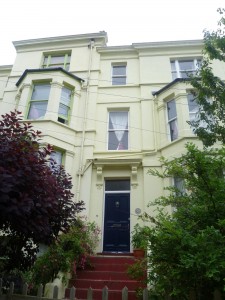
Mary Spink was reputed to be partial to a glass or three of ale. The nearest watering hole to the shop was the Albion Shades, on the corner of the mews directly opposite Chapman’s shop (it is now the crafts gallery Cuckoo Cuckoo). According to locals, Mary would secrete herself in the shop’s cellar and pass her ale-jug through the ventilators to a bartender, who would nip back across to the Shades, fill it up and pass it back to her. According to local gossip, the couple would leave young Willie locked in the cellar overnight ‘in the company of rats and filth’ whilst they went off to spend the night in their comfortable lodgings. The couple had taken furnished rooms within two of the more superior and spacious lodging houses in Hastings Old Town. Their first home, from March 1896, was at 10 Hill St then, from February 1897, they moved to 1 Cobourg Place, two minutes’ walk away. Just down the hill from Cobourg Place, on the corner of the High Street and Swan Terrace (then Swan Lane) stands a Georgian, bow-windowed shop. It is currently a jeweller’s, but in 1896 it was a pharmacy run by William Davison. He would visit Chapman’s shop two or three times a week to be shaved, and there is no doubt that the pair found much to talk about. Davison had lived in the East End throughout the 1860s and 70s, and so perhaps they aired their pet theories about who was responsible for the gruesome Ripper murders that had occurred in Whitechapel whilst Chapman lived there. They also discussed medical subjects and pharmaceutical matters, and Chapman purchased a couple of old medical books from Davison. He also bought an ounce of tartar emetic, for which he signed the poisons register in the usual fashion.
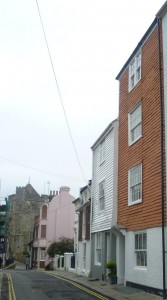
Hastings offered a wide range of amusements and leisure activities, and there were clubs and societies to suit most tastes, including Chapman’s known hobbies of photography and cycling. He bought a small sailing boat, which he called the Mosquito. Donning a nautical suit and P & O cap, he boasted that he would one day cross to Boulogne. In reality he only sailed up and down the coast. According to one story, the boat capsized and its occupants were jettisoned into the sea, from which they were rescued by local fishermen.
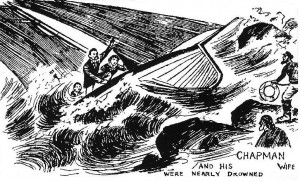
It was whilst they were still living in Hastings that Chapman began to poison Mary with the tartar emetic. The substance inflicted excruciating stomach pains and uncontrollable purging, which was witnessed by their neighbours Harriet Greenaway and Annie Helsdown, who — years later — were to give evidence against him. Mary and Chapman moved back to London in September 1897, continued to poison her, and she was dead within three months. He callously murdered his next girlfriend in exactly the same way, and then took the life of a third — a teenage girl who adored him — in an identically cruel, cold-blooded fashion. Chapman’s poison murders are utterly mysterious: he had no apparent motive for killing his three girlfriends, each of whom loved and trusted him implicitly. His connection with the Jack the Ripper killings adds another layer of mystery.
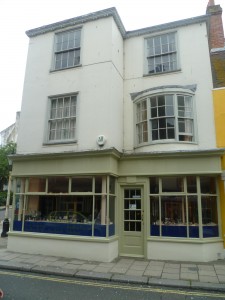
When Chapman was arrested for the third murder, retired Chief Inspector Abberline, who had charge of the Jack the Ripper murder investigation back in 1888, supposedly congratulated the arresting officer with the words: ‘You’ve got Jack the Ripper at last!’ He later announced his theory in two lengthy press interviews. By publicly naming him as the Ripper, Abberline ensured that Chapman would be included on every list of suspects and featured in every Jack the Ripper book, documentary, lecture and article right up to the present day.

Chapman’s crimes brought him international infamy. His Old Bailey trial was reported across the English-speaking world. Newspapers called him ‘the foulest criminal of the early twentieth century’ and listed him ‘among the most loathsome murderers in criminal history’. Hanged in 1903 for murdering three consecutive girlfriends, Chapman went to his grave within the grounds of Wandsworth Prison without admitting to either the poison murders or the Ripper murders.
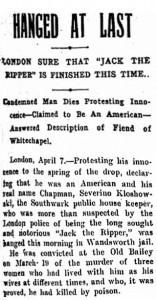
Retired Chief Inspector Abberline offered seven pieces of evidence that pointed to Chapman being Jack, and this list has been augmented over the years by many other researchers. There is currently a catalogue of fifteen separate points that support his candidacy. In 1996, after studying star charts, an astrologer concluded that Chapman was the Ripper. He was recently voted sixth (of 22 suspects) in a poll of Ripper experts, whilst in 2012 a renowned forensic psychological profiler ranked him second.
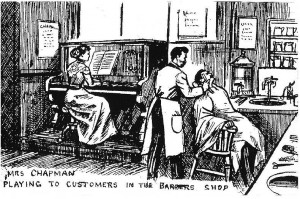
So, did Jack the Ripper live in Hastings? The truth is we will probably never know for certain who murdered those women in London in 1888, but Chapman is a very strong suspect. It is spine chilling to think that Jack the Ripper may have lived and worked in Hastings, and that many of the streets and buildings of Hastings Old Town, so familiar to us today, may once have echoed to the footsteps of the Whitechapel murderer.

Helena’s book ‘Jack the Ripper at Last: The Mysterious Murders of George Chapman’ details the grisly story of the three poison murders and assesses whether or not Chapman was Jack the Ripper. It is available on Amazon and Ebay, via the website www.hastingspress.co.uk. For non-internet orders, please telephone 01424 442142 (office hours).
Hastings Town January 2014
All articles, photographs and drawings on this web site are World Copyright Protected. No reproduction for publication without prior arrangement. © World Copyright 2015 Cinque Ports Magazines Rye Ltd., Guinea Hall Lodge Sellindge TN25 6EG
